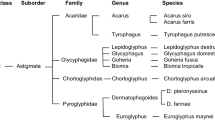Abstract
As a result of the German Therapy Allergen Ordinance and justified demands for large, double-blind, placebo-controlled studies on allergen-specific immunotherapy, rare therapy allergens as immunotherapeutic agents have moved out of the scientific and allergological spotlight. Allergen-specific immunotherapy with house dust mite extracts is well established, but beside house dust mites, storage mites may cause similar allergic symptoms that also require a causal treatment. Especially in Asia storage mites are the most important inhalative allergens, but they are important allergens as well for some patients in Germany. The cross-reactivity between house dust mites and storage mites but also cross-reactivity between different kinds of storage mites is low. Therefore, storage mites should be included in diagnostic procedures to prevent misdiagnosis in patients suffering from perennial rhinitis. Thus, manufacturer should guarantee the availability of storage mite extracts for diagnostics and allergen-specific immunotherapy. Clinical trials documenting the efficacy of these extracts are necessary.
Similar content being viewed by others
References
Klimek L. Seltene Allergene für die allergenspezifische Immuntherapie. Allergo J 2017;26(6):94–5.
Demoly P, Matucci A, Rossi O, Vidal C. A year-long, fortnightly, observational survey in three European countries of patients with respiratory allergies induced by house dust mites: Methodology, demographics and clinical characteristics. BMC Pulm Med. 2016;16:85.
Müsken H, Franz JT, Wahl R, Paap A, Cromwell O, Masuch G, et al. Sensitization to different mite species in German farmers: in vitro analyses. J Investig Allergol Clin Immunol. 2003;13:26–35.
Pfaar O, Bachert C, Bufe A, Buhl R, Ebner C, Eng P, et al. Guidelines on (allergen-)specific immunotherapy in IgE-mediated allergic diseases. S2k Guideline of the German Society for Allergology and Clinical Immunology (DGAKI), the Society for Pediatric Allergy and Environmental Medicine (GPA), the Medical Association of German Allergologists (AeDA), the Austrian Society for Allergy and Immunology (ÖGAI), the Swiss Society for Allergy and Immunology (SGAI), the German Society of Dermatology (DDG), the German Society of Oto-Rhino-Laryngology, Head and Neck Surgery (DGHNO-KHC), the German Society of Pediatrics and Adolescent Medicine (DGKJ), the Society for Pediatric Pneumology (GPP), the German Respiratory Society (DGP), the German Association of ENT Surgeons (BV-HNO), the Professional Federation of Paediatricians and Youth Doctors (BVKJ), the Federal Association of Pulmonologists (BDP) and the German Dermatologists Association (BVDD). Allergo J Int. 2014;23:282–319.
Raulf M, Bergmann KC, Kull S, Sander I, Hilger C, Brüning T, et al. Mites and other indoor allergens—from exposure to sensitization and treatment. Allergo J Int. 2015;24:68–80.
Sánchez J, Calvo V, Sánchez A, Díez S, Cardona R. Sensitization to 10 mites in a tropic area. Der p and Der f are important risk factor for sensitization to other mites from Pyroglyphidae, Acaridae, Chortoglyphidae, and Glyciphagidae families. Rev Alerg Mex. 2017;64:153–62.
Klimek L, Bardenhewer C, Spielhaupter M, Pitschner L, Harai C, Becker K, et al. Lokale allergische Rhinitis auf Vorratsmilben. Allergologie. 2015;38:1–10.
Becker K, Sperl A, Bardenhewer C, Spielhaupter M, Hörmann K, Pfaar O, et al. Allergenspezifische Immuntherapie bei Rhinitis allergica auf Vorratsmilben. Allergologie. 2017;40:179–89.
Armentia-Medina A, Tapias JA, Martín JF, Ventas P, Fernández A. Immunotherapy with the storage mite lepidoglyphus destructor. Allergol Immunopathol (Madr). 1995;23:211–23.
Author information
Authors and Affiliations
Corresponding author
Ethics declarations
Conflict of interest
L. Klimek has received research support, fees for consulting and/or expert testimony, fees for lectures and/or educational presentations and/or fees for board membership from ALK-Abelló, Allergopharma, Bencard, Bionorica, Biomay, Boehringer Ingelheim, Cytos, Circassia, HAL, GSK, Leti, Lofarma, MEDA, Novartis, Stallergenes und Roxall. K.-C. Bergmann declare that they have no competing interests. R. Brehler declares the following competing interests: Lectures: ALK, Allergopharma, Almirall, Astra Zeneca, Bencard, GSK, Dr. Pfleger, HAL, Leti, Merck, Novartis, Pierre Fabre, Pohl Boskamp, Stallergenes, Thermo-Fischer. Consultancy: Allergopharma, Bencard, HAL, Leti, Novartis. Clinical trials: Allergopharma, Bencard, Biotech Tools, Genentech, Leti, Novartis, Circassia.
Rights and permissions
About this article
Cite this article
Klimek, L., Brehler, R. & Bergmann, KC. Allergen-specific immunotherapy with storage mites. Allergo J Int 27, 15–19 (2018). https://doi.org/10.1007/s40629-017-0044-9
Published:
Issue Date:
DOI: https://doi.org/10.1007/s40629-017-0044-9




